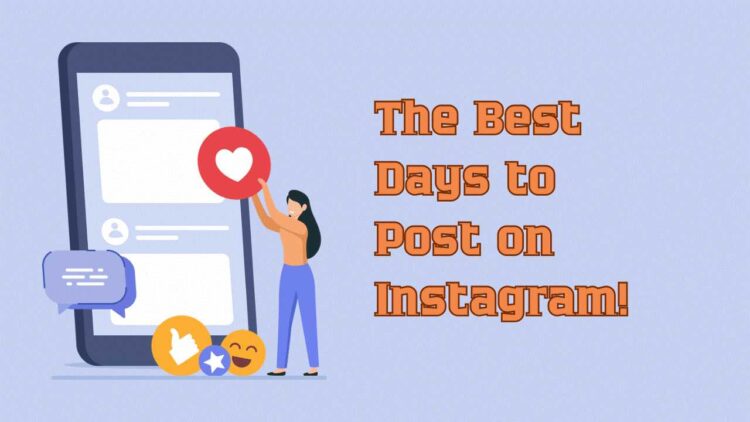Posting at the right time on Instagram is not a trivial matter—it can totally change the number of people who interact with your posts. Thanks to Instagram’s algorithm, posts that get likes and comments right away are more likely to appear in people’s feeds. So, if your post goes live just when your followers are scrolling, you have a good chance of getting more likes, comments, and shares.
It may seem ridiculous at first, but I have actually witnessed individuals get much more involved by simply posting a few hours later in the day.
What Studies Have to Say About Best Days and Times
Many studies suggest that the middle of the week is better than weekends. Common findings include:
- Tuesday, Wednesday, and Thursday receive more focus.
- Sunday tends to be quieter.
- Early in the morning (7–9 AM), lunch (11–1 PM), and night (6–9 PM) are suitable time frames when individuals are most likely to be on their phones.
But these aren’t rigid rules. They’re a starting point. You have to listen to your own audience to determine what actually works. Some users have incredible Sunday numbers because that’s when their audience is finally able to relax and scroll.
Know Your Audience
Daily habits of individuals truly count. If you’re targeting college students, they’ll probably be online at night. Busy professionals will catch Instagram at lunch or shortly after their workday ends. If you have followers all over the world, you’ll want to post at strategic times—i.e., post more than once so you’ll hit several time zones.
I figured this out the hard way myself when I realized half of my followers were in Europe and I was posting at midnight for them. Total facepalm moment.
Keeping an Eye on Instagram Insights
Your best friend here is Instagram’s built-in Insights.
Simply go to the Professional Dashboard, click Insights, and look at Total Followers and scroll through to view your Most Active Times. Take notice of when your people are actually online. One friend was insisting on posting daily at 7 AM, but the Insights revealed her audience was most active in the evenings.
The moment she changed to 9 PM, her engagement literally increased by 35% within weeks.
Testing and Experimentation
The only way to actually discover your sweet spot is to experiment:
- Experiment with sharing the same content at varying times and see which receives more likes, comments, shares, or saves.
- Continue to do this for several weeks to determine if there actually is a pattern or if this was a freak incident.
- Don’t forget to adapt if you see audience behavior change.
I used to think my prime time was 7 AM since I personally enjoy scrolling through Instagram when I’m drinking my morning coffee. But you know what? I was basically the only one awake. I changed it to 7 PM and received much more engagement. I should have probably looked at my own statistics earlier!
Industry-Specific Considerations
Various industries may have totally different peaks of engagement.
For example, fashion and beauty brands perform well during weekends and evenings. Content that is business or technology-related can do well in the mornings, possibly because people are scrolling through their feeds before they settle down to work. Food and travel can do very well at lunchtime or late at night.
If you are unsure, just take a glance at what your competitors are doing and observe how many likes or comments they receive on particular days.
One of the most reliable ways to plan your posts is knowing the best time to post on Instagram based on your niche and target demographic.
With the Help of Useful Tools
If scheduling by hand and testing all of it sounds like a bore, utilize schedule tools. I’ve employed some in the past:
- Later is extremely user-friendly and assists in visual planning.
- Hootsuite possesses advanced analytics that allow you to dive deep into metrics.
- Buffer is simple and effective if you are managing multiple accounts.
These applications allow you to post in advance, so you don’t need to be stuck to your phone at arbitrary times of the day.
Consider Seasonal and Cultural Factors
Do not forget that the behavior of people online may change based on weather, holidays, or major events.
For instance, during major holidays such as Christmas, you might see overall more activity, or maybe it dies down if everyone is out doing something else. If your audience is spread all over the world, then a U.S. holiday might not affect at all your followers in Europe or Asia. It’s always a good idea to keep an eye on those trends so you don’t get blindsided.
Some Final Recommendations
- Be consistent. Regular posting tells people when to expect updates.
- Quality matters more than quantity. Never spam your followers, but rather let your posts count.
- Stimulate interaction. Pose questions, respond to comments, or conduct speedy polls to get individuals discussing.
FAQ
Is there one optimal day to post on Instagram everywhere?
There’s just no one-size-fits-all answer. Although some studies indicate that midweek days might get more activity, what ultimately works depends on your particular audience.
How frequently should I alter my posting schedule?
You need to check in with your data every three to six months. People’s behaviors change, along with the trends.
What if my audience is spread across multiple time zones?
Stagger your posts to publish to various groups or figure out one or two times that reach the majority of your followers. Posting multiple times a day might be worthwhile if you’re trying to post to multiple time zones.
Do I post at the same time every time?
Consistency is great, but do not be afraid to experiment with new times every now and then. You may find an even better time slot.











